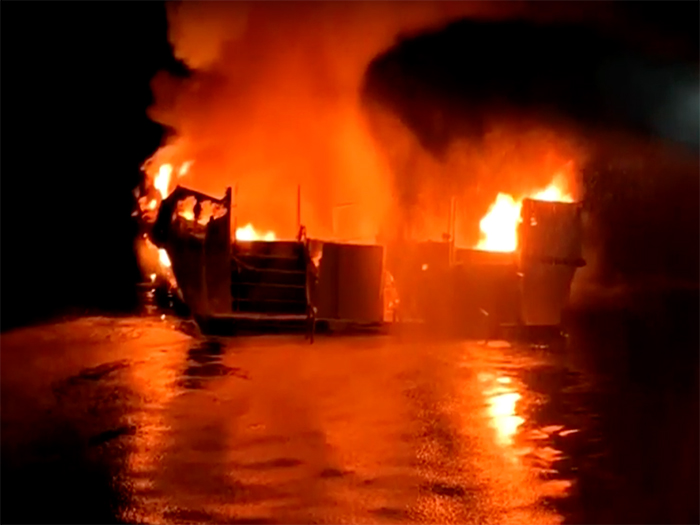
USCG issues interim rule on fire safety of small passenger vessels
Written by Marine Log Staff
KPIX CBS TV footage showed ferocity of fire that cost 34 lives
In response to the deadly Conception dive boat fire, the U.S. Coast Guard is issuing an interim rule as the first step to implementing statutorily mandated requirements for fire safety on certain covered small passenger vessels.
This interim rule adds additional fire safety requirements for small passenger vessels, including fire detection and suppression systems, avenues of escape, egress drills, crew firefighting training, watchmen monitoring devices, and the handling of flammable items such as rechargeable batteries.
Section 8441 of the Elijah E. Cummings Coast Guard Authorization Act of 2020 (2020 CGAA) amended Title 46 of the United States Code (U.S.C.), section 3306, which now directs the Secretary of the Department of Homeland Security (DHS) to prescribe fire safety regulations for certain “covered small passenger vessels,” defined as small passenger vessels (SPVs) with overnight accommodations for passengers or operating on Oceans or Coastwise routes, excluding fishing vessels and ferries.
The 2020 CGAA added a new paragraph (n) to section 3306 which requires the Secretary to issue interim requirements to cover the following eight provisions:
- Marine firefighting training programs to improve crewmember training and proficiency, including egress training for each member of the crew;
- Interconnected fire detection equipment and additional fire extinguishers and firefighting equipment in all areas on board where passengers and crew have access;
- Installation and use of monitoring devices to ensure wakefulness of the required night watch (for covered SPVs with overnight passenger accommodations);
- Increased fire detection and suppression systems in unmanned areas with machinery or areas with other potential heat sources;
- No less than two independent avenues of escape for all general areas accessible to passengers, that are constructed and arranged to allow for unobstructed egress, located so that if one avenue of escape is not available, another avenue of escape is available, and not directly above, or dependent on, a berth (for covered SPVs with overnight passenger accommodations);
- Handling, storage, and operation of flammable items, such as rechargeable batteries, including lithium-ion batteries;
- Requirements for passenger emergency egress drills (for covered SPVs with overnight passenger accommodations); and
- Providing all passengers a copy of the emergency egress plan for the vessel (for covered SPVs with overnight passenger accommodations).
For a detailed explanation of the changes in each category visit the interim rule on the Federal Register.
More in the Coast Guard’s Federal Register announcement




